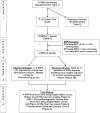Prognostic significance of host immune gene polymorphisms in follicular lymphoma survival
- PMID: 17327408
- PMCID: PMC1890834
- DOI: 10.1182/blood-2006-11-058040
Prognostic significance of host immune gene polymorphisms in follicular lymphoma survival
Abstract
Recent gene-expression data have suggested that host immune genetic signatures may predict outcomes in patients with follicular lymphoma. We evaluated the hypothesis that germ line common variation in candidate immune genes is associated with survival. Cox models were used to estimate hazard ratios (HR) and corresponding 95% confidence intervals for individual SNPs after accounting for age, clinical, and other demographic factors. The median age at diagnosis of the 278 patients was 57 years, and 59 (21%) of the patients died during follow-up, with a median follow-up of 59 months (range, 27-78 months) for surviving patients. SNPs in IL8 (rs4073; HR(TT)=2.14, 1.26-3.63), IL2 (rs2069762; HR(GT/TT) = 1.80, 1.06-3.05), IL12B (rs3212227; HR(AC/CC)=1.83, 1.06-3.06), and IL1RN (rs454078; HR(AA)=1.93, 1.11-3.34) were the most robust predictors of survival. A summary score of the number of deleterious genotypes from these genes was strongly associated with survival (P=.001). A risk score that combined the 4 SNPs with the clinical and demographic factors was even more strongly associated with survival (P<.001); the 5-year Kaplan-Meier survival estimates were 96% (93%-100%), 72% (62%-83%), and 58% (48%-72%) for groups at low, intermediate, and high risk, respectively. Common variation in host immune genes warrants further evaluation as a promising class of prognostic factors in follicular lymphoma.
Figures





References
-
- Gandhi MK, Marcus RE. Follicular lymphoma: time for a re-think? Blood Rev. 2005;19:165–178. - PubMed
-
- Solal-Celigny P, Roy P, Colombat P, et al. Follicular lymphoma international prognostic index. Blood. 2004;104:1258–1265. - PubMed
-
- de Jong D. Molecular pathogenesis of follicular lymphoma: a cross talk of genetic and immunologic factors. J Clin Oncol. 2005;23:6358–6363. - PubMed
-
- Horsman DE, Connors JM, Pantzar T, Gascoyne RD. Analysis of secondary chromosomal alterations in 165 cases of follicular lymphoma with t(14;18). Genes Chromosomes Cancer. 2001;30:375–382. - PubMed
Publication types
MeSH terms
Substances
Grants and funding
LinkOut - more resources
Full Text Sources
Miscellaneous

